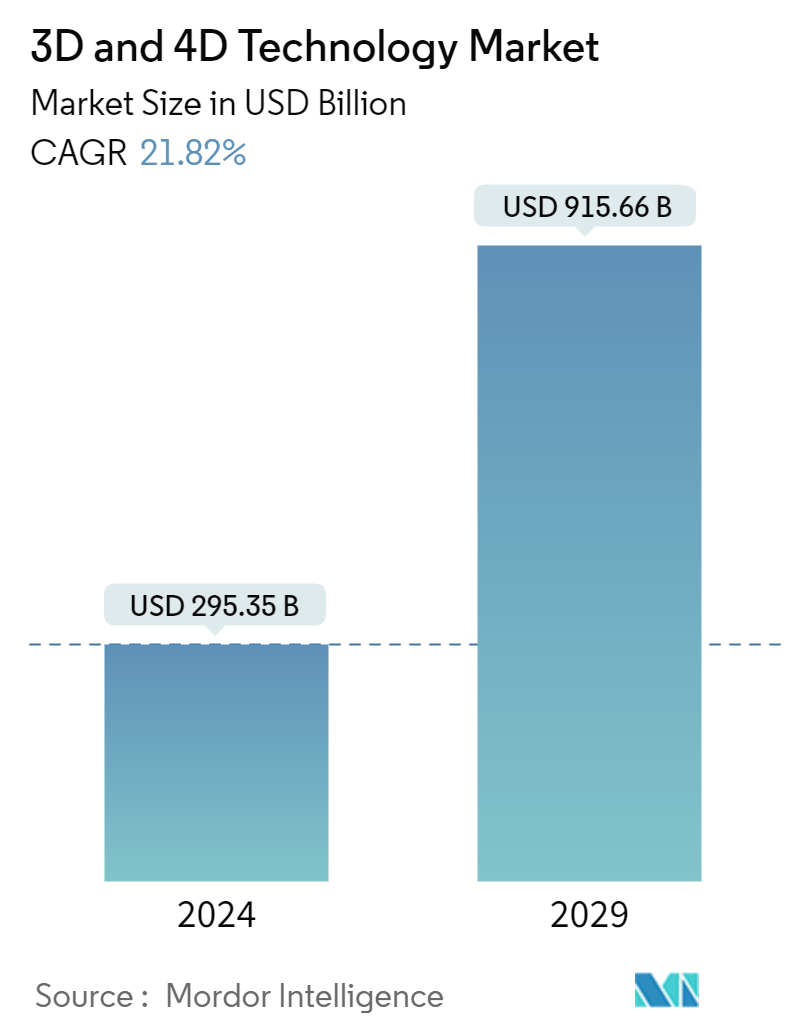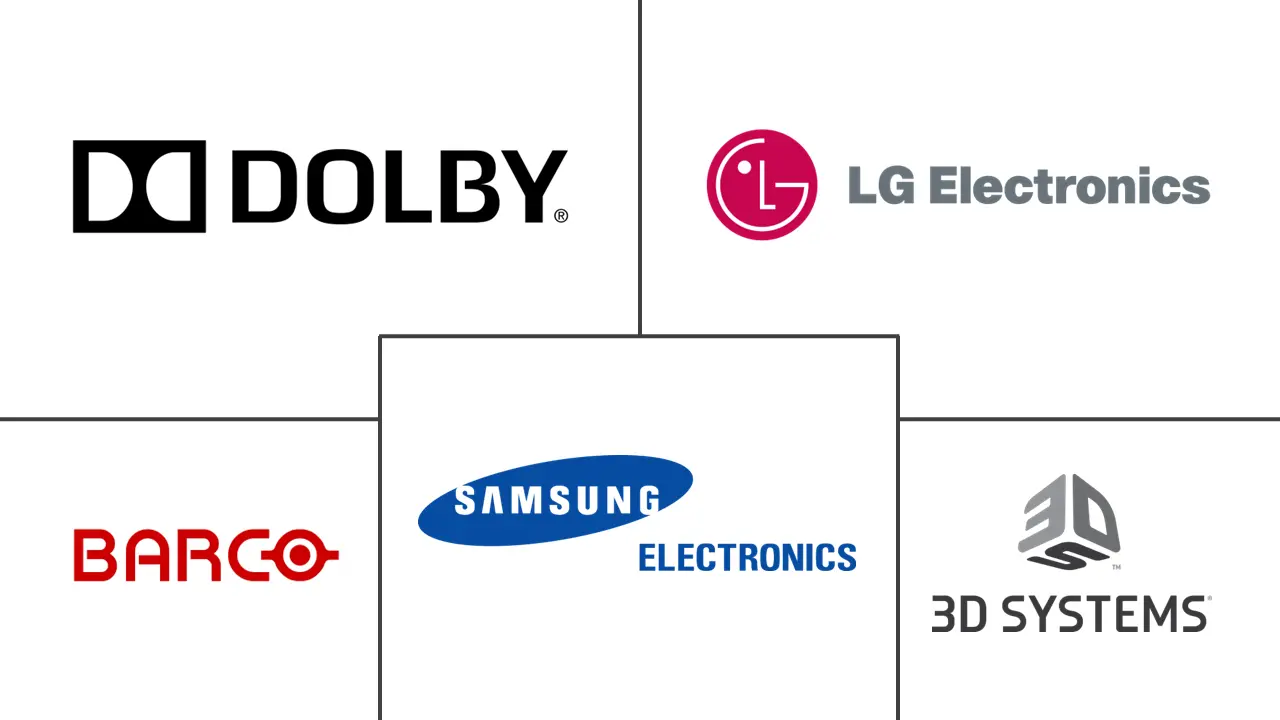Market Size of 3D & 4D Technology Industry

| Study Period | 2019 - 2029 |
| Market Size (2024) | USD 295.35 Billion |
| Market Size (2029) | USD 915.66 Billion |
| CAGR (2024 - 2029) | 21.82 % |
| Fastest Growing Market | Asia Pacific |
| Largest Market | North America |
Major Players
*Disclaimer: Major Players sorted in no particular order |
Need a report that reflects how COVID-19 has impacted this market and its growth?
3D & 4D Technology Market Analysis
The 3D & 4D Technology Market size is estimated at USD 295.35 billion in 2024, and is expected to reach USD 915.66 billion by 2029, growing at a CAGR of 21.82% during the forecast period (2024-2029).
3D and 4D technology are swiftly gaining popularity in various industries like healthcare, entertainment, education, manufacturing, automotive, and others due to their advanced visual effects, animations, and graphics capabilities. The 3D and 4D technologies provide a comprehensive platform for hand-drawn animation and physical impact. As a result of their superior technology, the adoption of 3D and 4D technologies has accelerated, which is likely to propel the market's growth.
- The increasing demand for 3D sensors in consumer electronics and the growing adoption of 3D sensors in the automotive industry is anticipated to drive the market's growth during the forecast period. The home gaming industry offered one of the first practical applications of 3D sensing for consumers, with time of flight (ToF) sensors capturing the movements and gestures of players to create a new interactive gaming experience.
- However, the arrival of 3D sensing is most noticeable in today’s smartphone technology. User-facing 3D scanning enhances security through facial recognition while world-facing 3D sensing creates new opportunities for high-performance depth-sensing photography and augmented reality. As the demand for 3D camera technology grows, illumination sources, LAS filters, and engineered diffuser production volumes are expected to soar.
- Further, biometric scanning and other 3D sensing applications are redefining the world of consumer electronics. Tablets and laptops are expanding on mobile devices' AR/VR, motion sensing, and security innovations. For instance, the gesture recognition capabilities of Microsoft Kinect that revolutionized the home gaming industry expanded to multi-player 3D position sensing, facial expression detection, and touchless heart rate monitoring.
- Face recognition functions have been added to 3D sensing applications, enhancing the security of laptop computers and mobile devices while boosting digital photo quality and resolution. Further, biometric scanning and other 3D sensing applications are redefining the world of consumer electronics. Tablets and laptops are expanding on mobile devices' AR/VR, motion sensing, and security innovations. For instance, the gesture recognition capabilities of Microsoft Kinect that transformed the home gaming industry expanded to multi-player 3D position sensing, facial expression detection, and touchless heart rate monitoring.
- Manufacturing with mixed materials or technological products (such as circuit boards) is still in production. 3D printed products are made of layers, which are not as strong as parts produced by conventional techniques, such as injection molding. Manufacturers currently need more in the size of products they can make with 3D printing. The technology’s ability to revolutionize mass-production manufacturing is still a long way off. Even today, 3D printers are still largely used for making one-off prototypes or small-scale print runs. Hence, the cost, availability, and material issues associated with 3D printing technologies hinder the market's growth.
- However, implementing 3D and 4D technologies can involve significant upfront costs, including hardware, software, content creation, and training. This cost barrier could limit adoption, especially for smaller businesses or industries with tighter budgets.
3D & 4D Technology Industry Segmentation
Technologies that use 3D visual representations to produce real-life or different virtual experiences. Such experiences range from technological overlap to fully immersive reality gadgets.
4D technology operates in all four conventional dimensions. It is a key notion in physics that, although referring to three-dimensional space (3D), also includes the dimension of time in addition to the other three dimensions (which are length, width, and depth).
The 3D 4D technology market is segmented by type (3D sensors, 3D integrated circuits, 3D transistors, 3D printers, 3D gaming, and other products), end-user industry (healthcare, entertainment & media, education, and other end-user industries), and geography (North America, Europe, Asia-Pacific, Latin America, and Middle East and Africa). The market sizes and forecasts are provided in terms of value in USD for all the above segments.
| By Products | |
| 3D Sensors | |
| 3D Integrated Circuits | |
| 3D Transistors | |
| 3D Printer | |
| 3D Gaming | |
| Other Products |
| By End-User Industry | |
| Healthcare | |
| Entertainment & Media | |
| Education | |
| Other End-user Industries |
| By Geography*** | |
| North America | |
| Europe | |
| Asia | |
| Australia and New Zealand | |
| Latin America | |
| Middle East and Africa |
3D & 4D Technology Market Size Summary
The 3D and 4D technology market is experiencing rapid growth across various sectors, including healthcare, entertainment, education, manufacturing, and automotive, driven by their advanced visual effects and graphics capabilities. These technologies offer a comprehensive platform for animation and physical impact, leading to increased adoption and market expansion. The demand for 3D sensors in consumer electronics and the automotive industry is a significant factor propelling market growth. Innovations in 3D sensing, particularly in smartphones and gaming, are enhancing security and creating new opportunities in augmented reality and depth-sensing photography. Despite the promising applications, challenges such as high implementation costs and material limitations in 3D printing technologies pose hurdles to widespread adoption.
The market is characterized by strategic partnerships and mergers among key players, aiming to expand their global presence and enhance their technological offerings. Companies like 3D Systems, Dolby Laboratories, and LG Electronics are at the forefront, leveraging collaborations to drive innovation and market penetration. The United States leads in adopting these technologies, with significant advancements in 3D bioprinting and sensor technologies contributing to market growth. Industries such as healthcare, aerospace, and automotive are increasingly utilizing 3D printing for prototyping and manufacturing, while consumer electronics see advancements in security and AR/VR applications. The market's consolidation is evident through strategic acquisitions and partnerships, which are expected to accelerate the adoption of immersive 3D experiences across various platforms.
3D & 4D Technology Market Size - Table of Contents
-
1. MARKET DYNAMICS
-
1.1 Market Overview
-
1.2 Introduction to Market Drivers and Restraints
-
1.3 Market Drivers
-
1.3.1 Increasing Applications of 3D Technology Across Various End-User Industries
-
1.3.2 Increasing Demand for 3D Technology in the Entertainment Industry
-
1.3.3 Increased Investment in R&D to Drive Development of Cost-Effective 3D Technology
-
-
1.4 Market Restraints
-
1.4.1 High Product Associated Costs and Availability of 3D Printing Materials
-
-
1.5 Industry Value Chain Analysis
-
1.6 Industry Attractiveness - Porter's Five Forces Analysis
-
1.6.1 Threat of New Entrants
-
1.6.2 Bargaining Power of Buyers/Consumers
-
1.6.3 Bargaining Power of Suppliers
-
1.6.4 Threat of Substitute Products
-
1.6.5 Intensity of Competitive Rivalry
-
-
1.7 Assessment of the impact of COVID-19 on the Market
-
-
2. MARKET SEGMENTATION
-
2.1 By Products
-
2.1.1 3D Sensors
-
2.1.2 3D Integrated Circuits
-
2.1.3 3D Transistors
-
2.1.4 3D Printer
-
2.1.5 3D Gaming
-
2.1.6 Other Products
-
-
2.2 By End-User Industry
-
2.2.1 Healthcare
-
2.2.2 Entertainment & Media
-
2.2.3 Education
-
2.2.4 Other End-user Industries
-
-
2.3 By Geography***
-
2.3.1 North America
-
2.3.2 Europe
-
2.3.3 Asia
-
2.3.4 Australia and New Zealand
-
2.3.5 Latin America
-
2.3.6 Middle East and Africa
-
-
3D & 4D Technology Market Size FAQs
How big is the 3D & 4D Technology Market?
The 3D & 4D Technology Market size is expected to reach USD 295.35 billion in 2024 and grow at a CAGR of 21.82% to reach USD 915.66 billion by 2029.
What is the current 3D & 4D Technology Market size?
In 2024, the 3D & 4D Technology Market size is expected to reach USD 295.35 billion.

